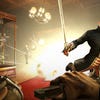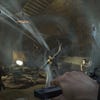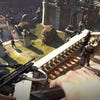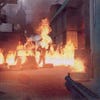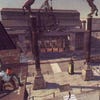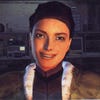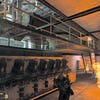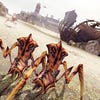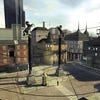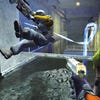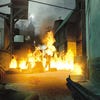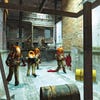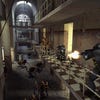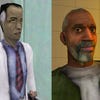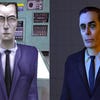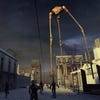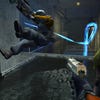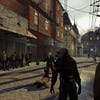"It's been a poor, poor five years for fiction in the video game industry"
The creator of Half-Life 2's City 17 and Dishonored tells us why.
That the closest touchstone for Dishonored should be BioShock, a game from 2007, speaks volumes to the stagnating creativity of video games. As celebrated art maestro Viktor Antonov put it to Eurogamer: "It's been a poor, poor five years for fiction in the video game industry." And he should know - he created Half-Life 2's iconic City 17, not to mention he's now making Dishonored.
"There have been too many sequels, and too many established IPs that have been ruling the market. And a lot of them are war games. And they're great projects and great entertainment, but there's a lack of variety today," he told us, perfectly framed by his trench coat, thick glasses, stylishly messy centre parting, measured Bulgarian tone and pinned leather sofa backdrop.
"So, when you step out of this established genre, people cannot grasp it, or the press tries to find a match.
"There's a place for thousands of different sub-genres and genres. Imagine the times when you were in the '40s and there were Westerns in Hollywood cinema: there were so many of them that none will be compared with another one, because there was a genre.
"We're doing a historical piece, a retro-futuristic piece, which has pretty much nothing to do with BioShock except for the fact that it doesn't take place in the far future, but has references to the past. And, unfortunately, BioShock and Dishonored are the only two games that go into that fiction for the past - how many years?
"So, lack of variety in what's in the market leads to associations like this. There should be more historical realistic worlds out there. And too bad there are not; I was expecting there to be 20 games like this."
BioShock Infinite and Dishonored were on course for an October 2012 clash until BioShock Infinite was delayed. "I didn't have any thoughts about that," Antonov shrugged. "I always love a good competition, art wise, and I'm very confident about the qualities of Dishonored, but I have no joy or sadness about this specific date."
"There should be more historical realistic worlds out there. And too bad there are not; I was expecting there to be 20 games like this."
Viktor Antonov, co-creator, Dishonored
Formally, Antonov is the visual design director for Bethesda's owner, Zenimax, and he makes sure "the level of visual design and fiction" coming out of studios like id Software, Bethesda Game Studios and Arkane is "the highest possible".
"I'm not a harsh critic of games," Antonov insisted. "I'm extremely happy of where technology has gone. But artists and art directors should make their own life a little bit harder by pushing management to take more artistic risks, and use the technology to a better, higher level. That's what I've been doing and suffering by - I've been spending as much time creating, as convincing the people who are financing games how important it is.
"We were always waiting for the next generation of great worlds or great graphics. Well, great graphics came; the worlds that came with these graphics are not up to the level of the graphics.
"Graphics used to be an excuse 10 years ago, that we can't make great worlds. Right now, we have a lot of New Yorks, we have a lot of war games. Please everybody," he pleaded, "let's do more science-fiction and more crazy worlds out there."
Antonov, ideally, would see games separate back into genres and away from the trend of fusing disciplines. "Because now a game is trying to pack too many games - narration, music, contemplation, shooting - that they lose the experience," he observed.
"Games should sort of split up and specialise and assume that there's such a thing as genre, and they shouldn't try to please everybody at the same time and try to make easy, diluted projects. Let's go for intensity and quality.
"Dishonored is one of these things that is stepping back into the side a little bit, and let's make a good stealth game with a hardcore, dark world, and go into detail."
(Antonov would also like to see "a beautiful revival of hardcore shooters". "Because," he explained, "it's a genre and every genre has to live, and that's the genre that created, really, video gaming and put it on a pedestal. Like Tarantino would embrace pulp and B-movies, shooters should be absolutely proud to be what they are, and go for all the adrenaline and spectacle they can.")
Dishonored
Antonov received a phone call from Arkane Studios' art director Sebastien Mitton in May 2009, asking him to help conjure a strong identity for a new IP, and fast. "There was a big project there that didn't exist," said Antonov, "so we jumped in and decided that's a once in a lifetime opportunity, let's go in there and try to come up with and create a brand new metropolis."
Antonov had worked with Arkane before on ambitious multiplayer game The Crossing - as well as on "a few other projects that will never be disclosed" - but that game was "intentionally put to sleep", as no publisher would allow Arkane to retain the IP rights, and Arkane couldn't bankroll a triple-A game without them.
It was a different situation with what turned out to be Dishonored. "The concept was strong enough that it found backing very easily with Bethesda," said Antonov, "who believed in it."
"Graphics used to be an excuse 10 years ago, that we can't make great worlds. Right now, we have a lot of New Yorks, we have a lot of war games. Please everybody, let's do more science-fiction and more crazy worlds out there."
Viktor Antonov
And believe in it Bethesda would have to, as a core team of Viktor Antonov, Sebastien Mitton, Harvey Smith and Raphael Colantonio sunk into pre-production for an unprecedented three years.
"That's an unusual situation," noted Antonov, "but it's thanks to Sebastien and my efforts to really bring something exceptional to the fiction of the game.
"Every drawing, to be cynical and material about it, costs a lot of money, a lot of effort, time, and it needs validation cycles from everybody, and it needs to be implemented with the game world. It's not doing fine art; these are things that need to be part of the game. We've made sure to be very, very particular about our work.
"There's always a turning point, a clicking point, when the whole team realise the value of art and the fiction of this game and the visual universe. Once we thought we were done, and we convinced people of our concept within the company, we started getting more requests and more requests, so we extended the pre-production until the end of the game, and we kept on drawing every detail, hand-drawing it, rather, than procedurally reproducing it.
"We wanted to hand-craft every asset according to the game experience," he told us.
Dunwall is modelled on London and Edinburgh, mid-1800s to 1930s. "London is a big metropolis, it's messy, it's chaotic and intense," Antonov said during a presentation at Develop earlier that day, "and it's both exotic and familiar to Americans and to Europeans, so it was just about perfect," he said. And being accessible to different cultures is very important, because "you want to communicate to a lot of people when you make a new piece of fiction".
London also has a rich history of plagues, fires and psuedo-mythical figures like Jack the Ripper. Edinburgh, on the other hand, provided a sense of containment, as well as its wealth of architectural delights. All of this was fused with a futuristic vision, but not Steampunk - not brass, not rivets, not steam. Arkane wanted Dunwall to be "contemporary and cool" as well as be "a period piece".
The stylised characters were inspired by the flamboyant illustrations of old adventure and pirate stories like Captain Blood. And tonally, Arkane wanted to be real, to be politically incorrect, if that was what the extensive field research called for.
The only games that inspired Dishonored was the work of now defunct studios like Looking Glass and Ion Storm. Antonov and Mitton didn't name-check, but there are obvious dollops of Thief and Deus Ex in Dishonored - not least because creative director Harvey Smith worked at Ion Storm during that era.
Personally, Antonov's been impressed by Mirror's Edge, which had a "pure and strong concept", used space "in a magnificent way", and had "a level of abstraction that's not often used in 3D, first-person games". It was a "very brave" game, and he's looking forward to a sequel "or whatever comes out". Sebastien Mitton's a Half-Life 2, Counter-Strike and Day of Defeat fan, though he too liked Mirror's Edge, and enjoys cruising aimlessly in the worlds of Grand Theft Auto.
"For me, if you take City 17 out here today (and 2004 was a long time ago), Dunwall is far superior by quantity of design, quality of design and precision. For me, it's absolutely up there to the level of craftsmanship and love that a gaming world can get."
Viktor Antonov
More inspiration for Dishonored fell out of Dunwall itself, a city designed by industrial engineers and Russian illustrators, rather than traditional video game artists. It was anatomists who were responsible for most of the character work, and Antonov and Mitton tracked down a textile carpet designer in Russia to paint key visual Dishonored art.
"We've put more work and effort in creating the schedule and assuring a longer pre-production than most people can do," evaluated Antonov. "Because of the nature of Arkane being a small, humane studio, we've worked it out that we can do this.
"In a bigger structure, will it be possible? It's not even a negotiable question.
"We have gone out of our way to defend the art part of the project, and set a very high standard - unusually high standard, in terms of precision and art production. Part of this was not just doing the drawings, but talking and communicating with the publisher and the game designers and creative directors that that's really necessary."
The results of Antonov and Mitton's artistic graft can be appreciated at a glance. Dishonored stands out a mile off. It's breath of artistic fresh air, in the claustrophobic mega war game-crammed climate we've become accustomed to.
Antonov stands by the integrity of his work, so much so that he believes that in Dunwall, he's outdone even City 17.
"For me, if you take City 17 out here today (and 2004 was a long time ago), Dunwall is far superior by quantity of design, quality of design and precision," he assessed.
"For me, it's absolutely up there to the level of craftsmanship and love that a gaming world can get."
By that measure, can Dishonored be as important as Half-Life 2?
"You never know this before the release date," Antonov answered. "The fans and the gamers and the players decide. There's this certain magic that you cannot plan.
"We have a pretty good excitement about the project now, but we'll know once someone has experienced the game, where art meets music meets gameplay meets rhythm - and that creates the thing that has no vocabulary, which is the game experience: these climactic, unforgettable moments that you get in three games in your life and you remember forever.
"We think we have them with Dishonored, and we hope the fans will feel them in October."
Also, for all Antonov's dislike of sequels, it sounds like Arkane's has hopes - if not plans - for another Dishonored game.
"Establishing a new IP, it's like, you know, growing something, and you have to grow it to its full extent," said Antonov. "There's so many opportunities to develop without repeating itself within Dunwall because we've created, actually, a whole universe. We are only showing one little chunk of it.
"We are not against sequels," Sebastien Mitton added. "What we dislike is that each sequel looks like the prequel ... just the technology is moving and it moves from a platform to another platform."



